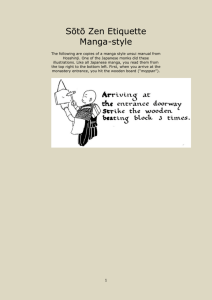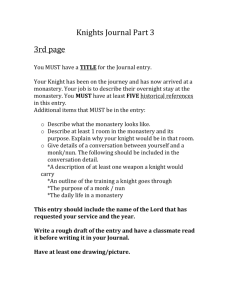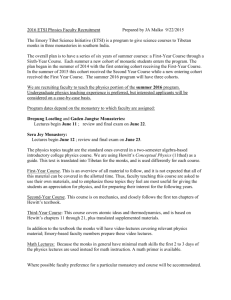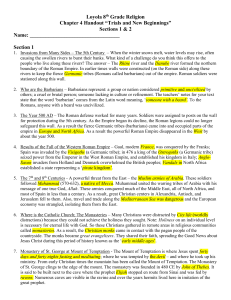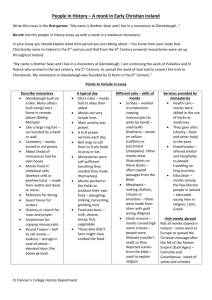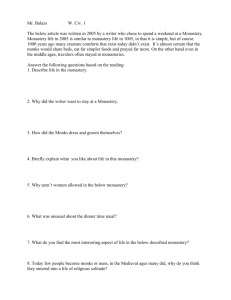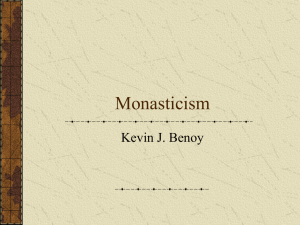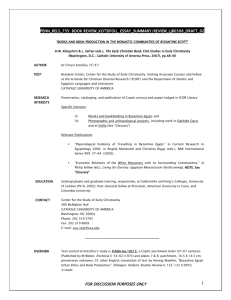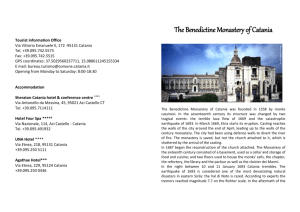Teaching in a Monastic Environment
advertisement
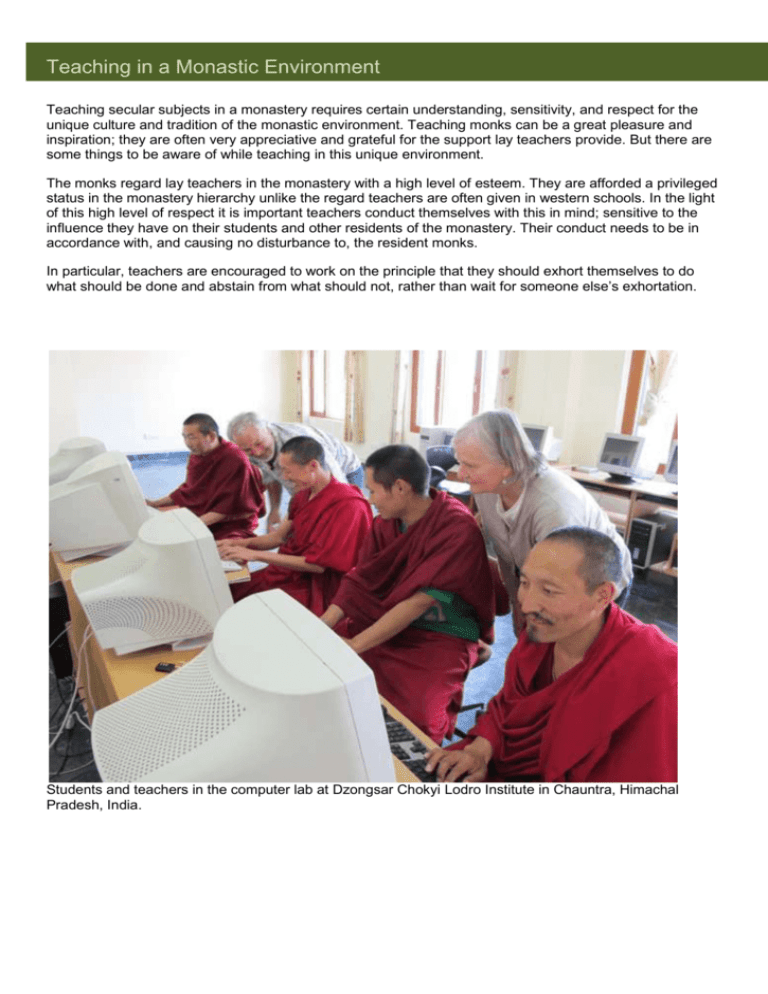
Teaching in a Monastic Environment Teaching secular subjects in a monastery requires certain understanding, sensitivity, and respect for the unique culture and tradition of the monastic environment. Teaching monks can be a great pleasure and inspiration; they are often very appreciative and grateful for the support lay teachers provide. But there are some things to be aware of while teaching in this unique environment. The monks regard lay teachers in the monastery with a high level of esteem. They are afforded a privileged status in the monastery hierarchy unlike the regard teachers are often given in western schools. In the light of this high level of respect it is important teachers conduct themselves with this in mind; sensitive to the influence they have on their students and other residents of the monastery. Their conduct needs to be in accordance with, and causing no disturbance to, the resident monks. In particular, teachers are encouraged to work on the principle that they should exhort themselves to do what should be done and abstain from what should not, rather than wait for someone else’s exhortation. Students and teachers in the computer lab at Dzongsar Chokyi Lodro Institute in Chauntra, Himachal Pradesh, India. Teaching in a Monastic Environment Some suggestions: Refrain from bringing outsiders into the monastery, especially at odd hours. Generally the right hand is used for giving or receiving anything, or use both hands, but never just the left. Likewise, the right side of the body is considered more respectful so when you are walking around the outside of temples, stupas, holy people, etc, always try to go clockwise. If you are walking with someone of great esteem it’s best to stay to their left, never directly behind or in front. Keep an orderly and modest standard of dress in class and in the monastery grounds. Before taking photos, ask monks for permission and respect their decision. It is considered impolite to point your feet at a person, shrine, or religious object. In general it's good to be careful where your shoes and feet are going. Similarly, it is considered impolite to point with a finger at a person or religious object. Generally it is better to use an upturned palm pointing with all fingers together. Be aware that there are hierarchies within the monastery. Lower ranking students could be shy and uncomfortable speaking in front of elders. And elders may avoid questions rather than lose face and make a mistake. Monks will therefore need lots of encouragement to 'speak up' and ask and answer questions. Homework may not be possible depending on the rigorous monastic schedule, but if possible it's a good way to teach the monks to think for themselves and work alone. Since learning by memorization is a strong suit for monks, which is cultivated by their dharma studies, they will feel comfortable if it can be incorporated into the class creatively. Once students feel comfortable with the teacher, role play is great to break up the class. All forms of acting are fun and a great way to learn. However depending on the monastic rules, singing and dancing activities are best avoided unless the monks are very young. Drawing, painting, looking at pictures from magazines/books, and a variety of games can make learning fun, but such aids should be respectful of monastic norms. Never speak in pigeon English. Just speak normally, but a bit slower, and repeat as needed. For women, dress conservatively, don't touch the monks, and maybe expect some distrust in the beginning. The technical limitations of power cuts, lack of technical support, and language barriers are challenging for our western, organised, linear minds, and coming from a world where most things by and large work and can be timetabled with some confidence. Planning and communication about what’s happening in the monastery are not always clear. Classes can be cancelled with very little, if any, notice; students can be unexpectedly taken out of class to do other monastery work; and the overall timetable for the monastery can be fluid. It requires a lot of flexibility and willingness to be happy not knowing what is going to happen in detail. So be aware classes probably won’t follow any kind of strict schedule and can be cancelled without warning for pujas etc. The phrase ‘dancing on the shifting carpet’ may be useful to remember. A good sense of humour and loads of patience are essential. The food provided in the monastery is usually adequate for nutritional purposes but by western standards, is limited and without the variety we have come to expect. Access to supplementary food can be difficult with monasteries often located some distance from large urban centres where a wider range of food can be purchased. If the food does not meet your needs, do not complain, but simply go about finding your own solutions. Exchanging US dollars, travellers cheques, or other currency can sometimes be a challenge. Be sure to bring bills in large currency that are freshly minted with no folds or rips. Do not expect to be able to use credit cards. Science can stray into dangerous areas and has to be handled with care to avoid confusion. Glossary of Terms Cadinchey – Thank you (Bhutan). Chapsang – Toilet. Also sangchod (Tibetan). the word comes from the word sang-wa which translates to secret. Secret business or work. Dasho – (Bhutan) A high ranking officer in the government. Traditionally, commoners wear white scrafs, dashos wear red, ministers wear orange and the kings wear yellow. The colored scarves are awarded only by the King. When a person gets the rank of Dasho, he is given the red scarf by the King together with a sword. It is similar to being 'knighted' in the English tradition. Dresi – Saffron rice with raisins and nuts served on special occasions. Gonda – Sorry. Kata (kadar) – white scarf offered as a way of greeting dignitaries and teachers. Khala – Tibetan for food. Kha- mouth and La-hand. Bhutanese will say tho for food, which means cooked rice, because Bhutanese cannot call anything food if it does not have rice. For side dishes they will say momsey. Khenpo – Professor or Senior Monk. Someone who in addition to receiving the highest academic degree is selected as head of a department of higher learning. A Khenpo is also the person who gives monastic ordination. Druk – Directly translates to Dragon. Tsangpa Gyare Yeshe Dorji (1161-1211), is said to have heard thunder when he founded the land where he was to build his seat. He said that it was the dragons who were flying through the skies to welcome him. When Bhutan was founded by Zhabdrung Nawang Namgyel, he decided to name Bhutan as Druk Yul ( Land of the Dragon). Kora – Circumambulation. Buddhists believe neither that good circumstances are bestowed by some higher power, nor that they happen at random. Hence Buddhists are active in numerous ways for the purpose of accumulating merit, the conditions for happiness. Kora is meritorious as it celebrates the awakening of enlightenment as embodied in the object of kora – such as a stupa, monastery, or sacred location. Drupchen – Translates to "great accumulation". A puja that goes on 24 hrs a day for a week or 10 days. Kyabje – Lord Refuge, a title for one’s main guru. Dzong – Literally “castle”, which in Bhutanese context is an administrative center. A dzongdag (from dzong and dag meaning owner/boss) is the head of administrative offices,equivalent to governors. Lhakhang – Temple. Literally house of the sacred. Lama – Guru – someone who possesses substantial qualities. La rey – Yes (Tibetan). La ma-rey - No (Tibetan). Dzongkhag – Municipality, area under the administration of a “Dzong”. Marchang ceremony – A greeting ceremony that consists of offering mar – butter, and chang – beer. Gegen – Teacher in Tibetan, teachers are also called Genlak. Gegen and Genlak can be teachers in both the monk body and lay teachers who teach in regular schools. Western Bhutanese (Dzongkha-pas) call their teachers Loeboe and Lopon. Dorje Lopon is a title given to high-level monks who preside over tantric rituals. ____-pa - In Tibetan the word "pa" means person. Pa is often added to a word to create the meaning that a person is of that root word, i.e. Drukpa means Bhutanese. Gelong – A person who has taken the full set of vows of monkhood, he is considered a full monk. The monks usually take different set of vows at different stages. They can take the full gelong vows only when they reach adulthood from an assembly of monks – headed by a senior monk - who hold those full vows themselves. Gewog – Group of gewogs (districts) make up a dzongkhag (state). Gomchen – Lay practitioners who are educated in Buddhist sciences and practices, but are not ordained. Gomchen can marry and have children. They have numerous responsibilities in the village., and usually wear robes that are simlar to the gho (Bhutanese men's dress) but will wear the yogi’s red and white shawl. The word literally means “great meditator”. Gompa – Monastery. Is a place of retreat or mediation. . Puja – Hindu or Buddhist ceremony or ritual. Can be modest or very elaborate. Rinpoche – An honorific title, like Reverend, meaning "precious one", that is applied to only very high lama usually only those who have been recognized as an incarnation of a great lama. Shesa (Zhepsa) – Respect; honorific language. Stupa – Also called a Chorten. A Buddhist structure that celebrates enlightenment, which is why a stupa is an object of vereration, and must be approached with respect, and circumambulated clockwise. Suja – Honorific for butter tea. Torma – An elaborate cake or piece of patisserie used in tantric practice. It can represent the principle of awakened reality (the “deity”), the offering itself, and it can also be used to throw – which is literally what torma means. Usually made from tsampa (barley flour) and butter


